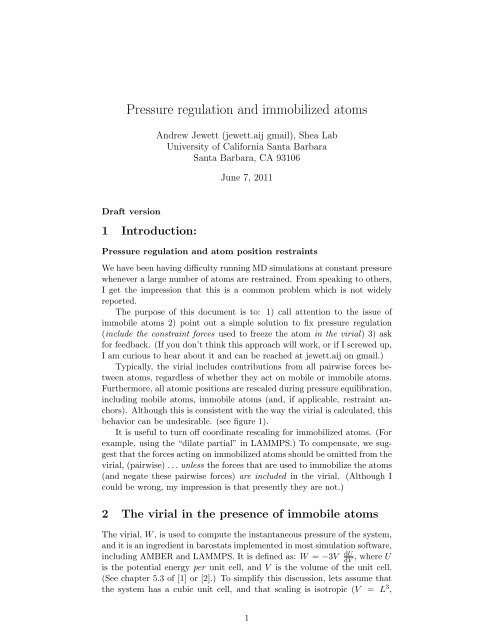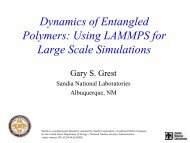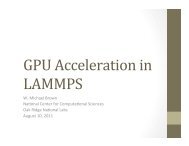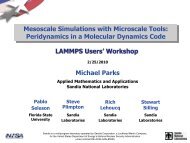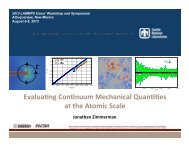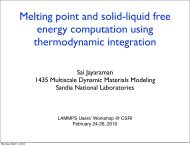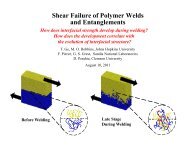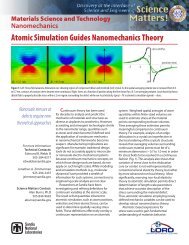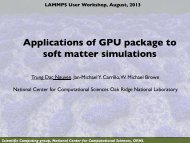Pressure regulation and immobilized atoms - Lammps
Pressure regulation and immobilized atoms - Lammps
Pressure regulation and immobilized atoms - Lammps
Create successful ePaper yourself
Turn your PDF publications into a flip-book with our unique Google optimized e-Paper software.
<strong>Pressure</strong> <strong>regulation</strong> <strong>and</strong> <strong>immobilized</strong> <strong>atoms</strong>Andrew Jewett (jewett.aij gmail), Shea LabUniversity of California Santa BarbaraSanta Barbara, CA 93106June 7, 2011Draft version1 Introduction:<strong>Pressure</strong> <strong>regulation</strong> <strong>and</strong> atom position restraintsWe have been having difficulty running MD simulations at constant pressurewhenever a large number of <strong>atoms</strong> are restrained. From speaking to others,I get the impression that this is a common problem which is not widelyreported.The purpose of this document is to: 1) call attention to the issue ofimmobile <strong>atoms</strong> 2) point out a simple solution to fix pressure <strong>regulation</strong>(include the constraint forces used to freeze the atom in the virial) 3) askfor feedback. (If you don’t think this approach will work, or if I screwed up,I am curious to hear about it <strong>and</strong> can be reached at jewett.aij on gmail.)Typically, the virial includes contributions from all pairwise forces between<strong>atoms</strong>, regardless of whether they act on mobile or immobile <strong>atoms</strong>.Furthermore, all atomic positions are rescaled during pressure equilibration,including mobile <strong>atoms</strong>, immobile <strong>atoms</strong> (<strong>and</strong>, if applicable, restraint anchors).Although this is consistent with the way the virial is calculated, thisbehavior can be undesirable. (see figure 1).It is useful to turn off coordinate rescaling for <strong>immobilized</strong> <strong>atoms</strong>. (Forexample, using the “dilate partial” in LAMMPS.) To compensate, we suggestthat the forces acting on <strong>immobilized</strong> <strong>atoms</strong> should be omitted from thevirial, (pairwise) ... unless the forces that are used to immobilize the <strong>atoms</strong>(<strong>and</strong> negate these pairwise forces) are included in the virial. (Although Icould be wrong, my impression is that presently they are not.)2 The virial in the presence of immobile <strong>atoms</strong>The virial, W, is used to compute the instantaneous pressure of the system,<strong>and</strong>itisaningredientinbarostatsimplementedinmostsimulationsoftware,including AMBER <strong>and</strong> LAMMPS. It is defined as: W = −3V dUdV , where Uis the potential energy per unit cell, <strong>and</strong> V is the volume of the unit cell.(See chapter 5.3 of [1] or [2].) To simplify this discussion, lets assume thatthe system has a cubic unit cell, <strong>and</strong> that scaling is isotropic (V = L 3 ,1
Figure 1: Snapshot of a simulation containing restrained highly repulsive<strong>atoms</strong>. Immobilizing restraints are particularly useful when applied to systemsthat would otherwise be unstable. As an extreme example, here weshow a frame of animation from a simulation of (default TIP3P) water interactingwith a slab of <strong>immobilized</strong> ice (middle) which has been held in placeusing harmonic restraints under NPT conditions (T = 300 ◦ K, P = 1 bar).The innermost layers of ice (white) have had their charges removed, allowingthe remaining Lennard-Jones forces to dominate, causing strong intermolecularrepulsion. Under NPT conditions, AMBER continues to exp<strong>and</strong> thesimulation box in a vain effort to relax the stress between repulsive (white)molecules, which are held in place by restraints. This cavitation problemgoes away if either: 1) the charges in the middle layer are restored, or 2)harmonic restraints are removed allowing the neutral (white) molecules toexp<strong>and</strong> to their equilibrium density.2
where L is the box size). I will assume that the forces contributing tothe virial are dominated by pairwise interactions between <strong>atoms</strong> (denotedu µν (|⃗r µ −⃗r ν |), where ⃗r µ <strong>and</strong> ⃗r ν are the positions of <strong>atoms</strong> µ <strong>and</strong> ν). (Iomitted a discussion of more general N-body interactions [2], because Idon’t use them in my current work. If someone asks, I’m happy to rewritethis document to include them.)The potential energy (per unit cell) is the sum of all pairwise energiesbetween <strong>atoms</strong>, <strong>and</strong> their images in other cells, <strong>and</strong> can be written as:U = 1 ∑ ∑u µν (|⃗r µ −(⃗r ν +L⃗m)|)2⃗m∈Z 3 µ≠ν(1)useful notation: ⃗r ν,⃗m ≡ ⃗r ν +L⃗m (2)= 1 ∑ ∑ (∣ ∣)u µν ∣ ⃗r µ −⃗r ν,⃗m 2⃗m∈Z 3 µ≠ν(3)where ∑ µ≠νis a sum over all pairs of <strong>atoms</strong> in the system (mobile orimmobile), <strong>and</strong> ∑ ⃗m∈Z 3 is a sum over an atom’s images in all surroundingunit cells (located at position ⃗r ν +L⃗m, where ⃗m, is a vector with integerx,y,zcomponents). Thefactorof 1 2 compensatesforredundancyofequivalentpairs (µ ↔ ν). This yields:W = −3V dUdV= −L dUdL(where V = L 3 ) (4)= − L 2(∑ ∑ d⃗r µdL · ∂u (∣ ∣)µν ∣ ⃗r µ −⃗r ν,⃗m + d⃗r ν,⃗m∂⃗r µ dL · ∂u (∣ ∣)µν ∣ ⃗r µ −⃗r ν,⃗m ∂⃗r⃗m∈Z 3 µ≠νν,⃗m} {{ } } {{ }= −f ⃗ ν,⃗m→µ= − ⃗ f µ→ν,⃗m)(5)One can recognize − ∂∂⃗r µu µν(∣ ∣ ⃗r µ −⃗r ν,⃗m∣ ∣)as the force acting on atom µ exertedby atom ν’s image in unit cell indicated by ⃗m (denoted ⃗ f ν,⃗m→µ ). Wenow split this sum into terms involving mobile <strong>and</strong> immobile <strong>atoms</strong>. Weuse lower-case indices (i,j) to refer to mobile <strong>atoms</strong>, <strong>and</strong> upper-case indices(I,J) to refer to immobile <strong>atoms</strong>, respectively. Expressed this way, W =L2∑⃗m∈Z 3 ( ∑i≠j+ ∑ i,J( d⃗ridL ⃗ f j,⃗m→i + d⃗r j,⃗mdL ⃗ f i→j,⃗m)+ ∑ I,j( d⃗ridL ⃗ f J,⃗m→i + d⃗r J,⃗mdL ⃗ f i→J,⃗m)+ ∑ I≠J( d⃗rIdL ⃗ f j,⃗m→I + d⃗r j,⃗mdL ⃗ f I→j,⃗m)( d⃗rIdL ⃗ f J,⃗m→I + d⃗r J,⃗mdL ⃗ f I→J,⃗m) ) (6)Weusethenotation: ⃗s i ≡⃗r i /Ltodenotethenormalizedcoordinatesofatomi. The x,y,z components of ⃗s i lie in the range from 0 <strong>and</strong> 1. Because mobile(unconstrained, lower-case) atom positions are rescaled during pressureequilibration, this means that ⃗r i <strong>and</strong> ⃗r j are proportional to L (⃗r j = L⃗s i ),<strong>and</strong> consequently, ⃗s i <strong>and</strong> ⃗s j are independent of L. Consequently:L d⃗r idL = ⃗r i<strong>and</strong> L d⃗r j.⃗mdL = ⃗r j,⃗m = ⃗r j +L⃗m (7)3
(See equation 2.) Let us assume, for the moment that <strong>immobilized</strong> <strong>atoms</strong>are not rescaled during pressure equilibration. This means that:d⃗r IdL = d⃗r JdL = 0 <strong>and</strong> thus d⃗r I,⃗mdL = d⃗r J,⃗mdL= ⃗m (8)After substituting equations 7 <strong>and</strong> 8 into 6, <strong>and</strong> some additional simplification(appendix A) we find that the following terms (denoted ∆W im ) are leftout of the virial:∆W im = ∑ I⃗r I · ∑⃗m∈Z 3 ⎛⎝ ∑ j⃗f j,⃗m→I + ∑ J>I⃗f J,⃗m→I⎞⎠ (9)These terms would otherwise be present if the <strong>immobilized</strong> <strong>atoms</strong> (withindices I, <strong>and</strong> J) were scaled with the box-size during pressure equilibration.Simulation programs typically include all of these pairwise force terms.To correct the virial, one could subtract these terms (∆W im ) from the virialas∑calculated by the simulation program. We can recognize the sum over⃗m∈Z 3 as the net pairwise force acting on atom I. Hence we can calculatethis correction to the virial knowing only the net force acting on each atom.Alternately, one can apply the restraint forces which negate these beforecalculatingthevirial. (Thisisreallythesamething, becausetheseconstraintforces would have contributed −∆W im to the virial.) For completeness, anexpression for the full virial is given in equation 10 in appendix A.Appendices:A Simplifying the virialI skipped a few steps when deriving equation 9. The are included here.Substituting equations 7 <strong>and</strong> 8 into equation 6 completely eliminates termscontaining ⃗ f j,⃗m→I , ⃗ fJ,⃗m→I , <strong>and</strong> reduces the number of terms containing⃗f i→J,⃗m , <strong>and</strong> ⃗ f I→J,⃗m . We are left with:W = 1 2∑⃗m∈Z 3 ( ∑i≠j(⃗r i · ⃗f j,⃗m→i +(⃗r j +L⃗m)· ⃗f)i→j,⃗m + ∑ ((⃗r j +L⃗m)· ⃗f)I→j,⃗mI,j+ ∑ (⃗r i · ⃗f J,⃗m→i +L⃗m· ⃗f)i→J,⃗m + ∑ (L⃗m· ⃗f) )I→J,⃗m (10)i,JI≠JThis expression for the virial can be written in multiple equivalent ways.Note that: ⃗ fi → j,⃗m (the force from atom i acting on the image of atom j inunit cell ⃗m) is identical to ⃗ f i,−⃗m → j (the force acting on <strong>immobilized</strong> atomj, coming from the image of atom i in unit cell −⃗m).The terms which (as a result of immobilizing of some of the <strong>atoms</strong>), are4
absent from this summation (denoted ∆W im ), are:∆W im = 1 2(∑ ∑⃗r I · ⃗f j,⃗m→I + ∑ ⃗r J · ⃗f i→J,⃗m⃗m∈Z 3 I,j i,J+ ∑ (⃗r I · ⃗f J,⃗m→I +⃗r J · ⃗f) )I→J,⃗m (11)I≠JByusingtheidentities: f ⃗ i → J,⃗m = f ⃗ i,−⃗m → J <strong>and</strong>f ⃗ I → J,⃗m = f ⃗ I,−⃗m → J , <strong>and</strong>replacing ⃗m by −⃗m, in the sum ∑ ⃗m∈Z 3 (since we are summing over bothpositive <strong>and</strong> negative x,y,z components of ⃗m), <strong>and</strong> combining <strong>and</strong> eliminatingredundant terms (<strong>and</strong> eliminating the factor of 1 2), we can justifyequation 9.References[1] Louis, A., “Computer Simulation Methods in Chemistry <strong>and</strong>Physics, Part III”, Section 5.3, 94-95, (2005)http://www-thphys.physics.ox.ac.uk/people/ArdLouis/teaching.shtml[2] Thompson, A.P., Plimpton, S.J., Mattson, W., “General formulationof pressure <strong>and</strong> stress tensor for arbitrary many-body interactionpotentials under periodic boundary conditions” J. Chem.Phys., 131, 154107, (2009)5


